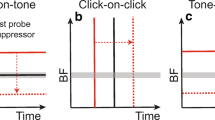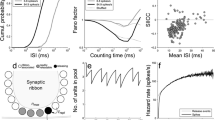Abstract
THE sharp frequency selectivity of single primary auditory neurones in mammals contrasts with the poor mechanical tuning of the basilar membrane1,2. This discrepancy has generally been explained by postulating some filter mechanism interposed between the basilar membrane and the excitation of auditory afferents2–4. A further property of these neurones which probably cannot be explained by basilar membrane behaviour alone is two-tone inhibition whereby the simultaneous presentation of a second tone reduces the response of a neurone to a first tone at the best, or characteristic frequency5–8. It has been suggested that this inhibition may also be a property of the additional cochlear mechanisms which follow the basilar membrane9. I now present evidence that the loss of sharp frequency selectivity of primary neurones is intimately linked to changes in two-tone inhibition and that the two phenomena might be related to a common mechanism which is vulnerable to perilymph removal.
Similar content being viewed by others
References
Wilson, J. P., Johnstone, J. R., J. acoust. Soc. Am., 57, 705–723 (1975).
Evans, E. F., J. Physiol., Lond., 226, 263–287 (1972).
Wilson, J. P., and Johnstone, J. R., Nature, 241, 206–207 (1973).
Evans, E. F., Wilson, J. P., in Basic Mechanisms in Hearing (edit. by Moller, A. R.), 519–557 (Academic, New York, 1973).
Nomoto, Suga, N., and Katsuki, Y., J. Neurophysiol., 27, 768–787 (1964).
Sachs, M. B., Kiang, N. Y. S., J. acoust. Soc. Am., 43, 1120–1128 (1970).
Kiang, N. Y. S., Discharge patterns of single fibres in the cat's auditory nerve (MIT Press, Cambridge, Massachusetts, 1965).
Arthur, R. M., Pfeiffer, R. R., and Suga, N., J. Physiol., Lond., 212, 593–609 (1971).
Pfeiffer, R. R., J. acoust. Soc. Am., 48, 1373–1378 (1970).
Robertson, D., and Manley, G. A., J. comp. Physiol., 91, 363–375 (1974).
Robertson, D., Science, 186, 135–155 (1974).
Moller, A. R., Acta physiol. scand., 78, 299–314 (1970).
Johnstone, J. R., Johnstone, B. M., and Yates, G. K., J. acoust. Soc. Am., 57, 1210–1211 (1975).
Author information
Authors and Affiliations
Rights and permissions
About this article
Cite this article
ROBERTSON, D. Correspondence between sharp tuning and two-tone inhibition in primary auditory neurones. Nature 259, 477–478 (1976). https://doi.org/10.1038/259477a0
Received:
Accepted:
Issue Date:
DOI: https://doi.org/10.1038/259477a0
- Springer Nature Limited
This article is cited by
-
Two-tone suppression of an identified auditory neurone in the brain of the cricketGryllus bimaculatus (De Geer)
Journal of Comparative Physiology ? A (1981)
-
Auditory nerve fibre activity in the tokay gecko
Journal of Comparative Physiology ? A (1981)





